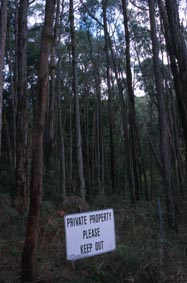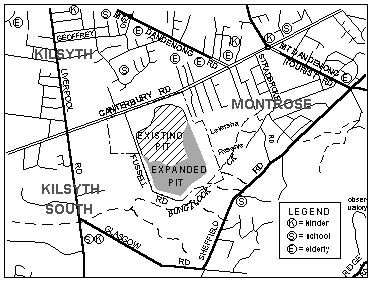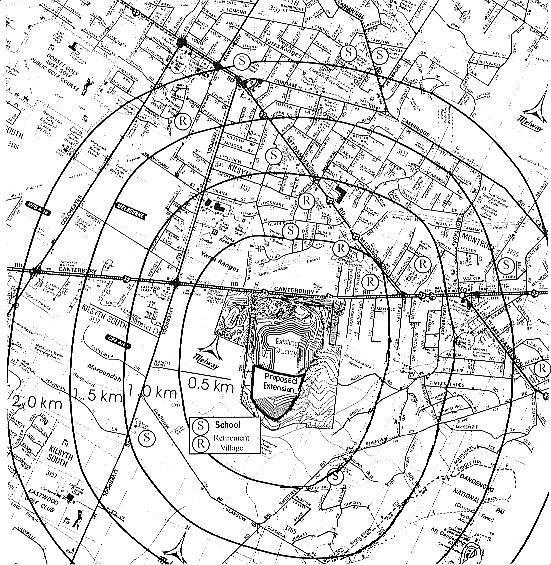Montrose Quarry Campaign 1999
The following sections are copied from documents that MEG produced during the initial campaign against the expansion of Montrose Quarry in 1999. Please note that much of the information is outdated and is only provided for historical interest.
For the current status of the quarry, see the main page.
The Montrose Environmental Group opposes the proposed expansion of the Montrose Quarry. This quarry is located in the heart of an environmentally sensitive area and we believe that the expansion will have significant adverse environmental effects.
Dust

The quarry, as a result of the crushers, rock blasting and breaking, rock movement and stockpiling, and traffic movement in the site produces dust. All quarries issue dust and it is usually one of the major nuisance matters for quarry operators as well as a health threat.
Inhalation of minute dust particles (called PM10) is known to cause significant health effects including premature death and an increase in respiratory illnesses. Children and the elderly are most at risk.
The quarry emits these particles. A handful of measurements have been taken just inside their fence, and these were far above the national public health standard. Dust created by the quarry is principally from the crushers and by movement of crushed rock to the stockpiles. The stockpiles are in themselves sources of significant dust.
The proposed expansion would seem to result in significant additional dust being generated and emitted into the environment. This dust settles on local houses and areas creating additional nuisance for residents. Dust emitted by the quarry is entrained by traffic, particularly from Canterbury Road, and spread far and wide.
The proposed expansion of the quarry will result in dust being spread around the local area for an increased number years into the future. This will result in a reduction in the quality of life, especially for residents to the south of the quarry. As the ridge between the quarry and the southern areas is removed, dust sources will move closer and a significant mitigating factor on dust movement will be removed. Important loss of amenity is likely to result.
Noise

Quarry operations are noisy. Montrose Quarry in 1999 was no exception. Both continuous and intermittent noise sources were present. Noise limits must be complied with by the Quarry to ensure that the local environment is not degraded.
Noise still is a key issue of concern for local residents, being obvious and intrusive.
Noise inside the quarry operations will continue to be generated over the life of the proposed expansion. Studies conducted by Boral's consultants in the '90's, showed that the noise emitted by the quarry will not substantially change over time.
The crushers that constantly crush the extracted rock into smaller and smaller fragments make continuous noise. These give off a loud and penetrating drone. Many residents complained about the way that the noise from the crushers bounced around the valley south of the quarry.
Truck traffic makes varying noise levels. Haul trucks and loaders within the quarry are on the move continually during operations. Transport trucks arrive empty and are filled. Often filling results in loud crashes and thumps as empty metal bins are loaded. Also a number of pieces of plant emitted penetrating discrete sounds. Rock breakers had a strong percussive noise that has been commonly mentioned by disturbed residents.
In some areas Boral has made improvement. Normal office and yard operations, such as outside telephone ringers and loud speaker systems provided intermittent and annoying noise. All trucks and mobile plant had very loud and penetrating reversing beepers that were a constant nuisance to local residents.
Have these been sufficiently modified to reduce these noises to the satisfaction of local residents and businesses?
Noise from the quarry is a source of annoyance and discomfort for many residents. Many of the residents to the south of the current operation are shielded from noise by the large ridge that runs east-west, to the south of the current pit. When this ridge is diminished, residents south of the quarry will experience significant increases in noise. This will continue for the full period of the expansion.
Noise in the area of the quarry had been measured as being in excess of SEPP N-1 Limits. This noise level would significantly degrade the environment of local residents for longer and over a larger area as a result of the expansion.
Bungalook Creek

Bungalook Creek is an important and largely undisturbed watercourse. Studies of the water quality have found that although under pressure from surrounding areas, it maintains a high ecological diversity. Platypuses have been recorded in the creek system in the vicinity of the Quarry.
Expansion of the Quarry could result in surface drainage from quarry land flowing toward the creek. This may have the potential to significantly reduce the clarity of the water and modify the chemical nature of the waters, reducing the environmental worth of the creek.
We await the details of reports to see the extent of effects on this creek corridor.
Can the Operation of the quarry avoid significant transport of sediment into the creek once the current ridgeline is breached? Can silt traps protect the creek from large storm events? This threat to the creek could persist for tens of years.
Will expansion of the quarry result in runoff entering the creek and lowering the environmental value of the creek system? Will the diversity of the creek be reduced as a result and cause a loss of environmental value?
Habitat

Land where the quarry will expand is currently covered by important native vegetation. Expansion of the quarry into this land may effect this habitat. The quarry must remove some vegetation to expand.
Expansion of the quarry may result in the permanent loss of some native vegetation. This should not be allowed. We must be certain they preserve habitat, avoid greenhouse gas emission and maintain the environment generally.
Native vegetation on the quarry land is classed as "regionally significant". The ecosystem there is generally in good condition. The land provides habitat for important flora and fauna, such as the Powerful Owl. Loss of this land could mean a permanent reduction in the available habitat for rare species.
It is proposed to re-vegetate the site after quarrying has been completed. Whilst vegetation cover may be able to be established, the complex and highly diverse ecosystem which is currently on the site can never be re-established after quarrying.
Blasting

Blasting with explosives is undertaken by the current quarry and is proposed to continue with the expansion. Explosives are placed into holes drilled in the rock and in a series of timed explosions large areas of rock face are shattered to enable extraction and crushing. Blasting is essential for ongoing rock extraction.
Blasting has two main impacts: air blast and ground vibration.
Air blast
A rush of air that moves out from the blast site accompanies each explosion. Limits are set for the force that can be experienced at neighbouring properties.
With the proposed expansion these limits may be exceeded for a number of properties to the east of the site unless strict limits on the size of explosions are met. In other areas, significant increases in the effect of blasts will be felt. To the south of the site, residences may experience an increase in air blast due to expansion. Many of these affected properties have livestock that maybe adversely affected by continued blast effects.
Ground vibration
Explosions shake the ground for some distance around the blast site. Limits have been set for avoiding structural damage to houses. Properties to the east of the site may exceed these limits unless strict conditions on blasts are enforced. Properties to the south and east may experience increases in the effects of blasting.
This may include areas that are designated high landslide risk within the Shire of Yarra Ranges. Residential properties around the quarry may experience significant increases in the effects of blasts. They may suffer loss of amenity as a result of these increased effects. These effects may continue for many extra years into the future.
Visual impact

The quarry will remove a major topographic ridge that forms a feature for the local area. Inspection of topographic maps shows that the line of sight for many residences will be significantly altered by the proposed expansion.
Already the quarry is a prominent scar on an otherwise green landscape. This can be seen from many adjoining suburbs, such as Croydon, Bayswater and Mt Dandenong. The proposed expansion would result in a significant scar on the landscape that could be seen from the Mt Dandenong Observatory. Whilst re-vegetation is proposed to occur along with quarry activities, it is clear from the current level of visual impact that the quarry will significantly change the visual appeal of the area for the worse.
Properties which currently enjoy a natural landscape view to the south, southeast, southwest and distant north will have their view significantly degraded by quarry expansion. The quality of life that is enjoyed by these residents will be significantly reduced as a result.
The expanded quarry will form a visible disruption to the landform and aesthetic value of the region, with significant tourist points such as Mt Dandenong Observatory seeing a reduction of natural landscape. Properties on the side of Mt Dandenong to the south of the quarry will have severe visual disturbance for 20 to 30 years.
Final use

Boral seem to have no generally agreed feasible final plan for the site after quarrying. Is making the pit even larger only going to exacerbate an already large headache?
Finding a possible and feasable end usage is difficult enough already given the cavernous size and shape of the pit. Some concepts have been suggested. But how will the proposed expansion facilitate or hinder any possible end use?
Filling the whole pit with water now seems to be shown to lack feasibility. Even if filled with water there would be significant areas of open benches that would need long-term maintenance and inspection.
Will such a large hole be unstable and unsafe in the long term?
Many quarries are used for landfill once completed. This site would be totally inappropriate for landfill development.
Will the local community be expected to take on a long-term liability in terms of the hole in the ground once Boral has completed operations? Is making the pit even larger only going to exacerbate an already large headache? The existing hole is bad enough, without a major expansion.
Summary

The relevant authorities already considered the issue of the expansion of the quarry in the 1960's. At that time the expansion was regarded as unnecessary because of the environmental impact. This impact would only be more pronounced now. It was bad planning in the 1960's. At the turn of the century, to expand the quarry would be to steal from our future generations the right to enjoy the Montrose environment as it is. The quarry expansion should be stopped!
Regionally significant vegetation will be destroyed. The ecological community, which is present in the land to be quarried, is regionally significant. It can never be replaced if lost. This habitat provides shelter for important local species such as the Powerful Owl and Platypus. Re-vegetation of a disturbed area is not the same as protecting an area in a largely undisturbed state.
Quarry operations emit fine particles that represent a potential health hazard for local residents. Given the number of schools, kindergartens and elderly peoples homes within one kilometer of the site, expansion or continuation of the quarry which may expose these vulnerable groups to fine particles is irresponsible. Noise from quarry operations and intrusions due to blasting will affect more residents and increase for many residents. The special qualities of Montrose and the amenity of the area will be irrevocably lost should the proposal proceed.
The expanded quarry will be a significant change in the landform and visual values of the area. The scar left by the expansion will irrevocably change the character of the area, destroying most of the visual amenity enjoyed by many thousands of residents.
Discharge from the quarry has the potential to significantly alter the habitat values of Bungalook creek. As well as providing important habitat, this creek discharges into urban areas and contamination of the creek could lead to silting of flood retarding structures and degradation of drainage lines.
The enormous gaping hole left by the quarry will be hard to rehabilitate. The area cannot be reclaimed by construction of a 100-meter deep lake. Water quality and management of such a deep lake is highly complex. The existing hole will be hard enough to rehabilitate, let alone one twice as deep.

